Saving Face

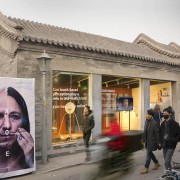
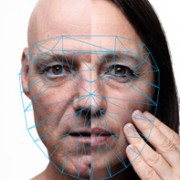
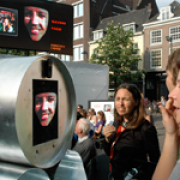


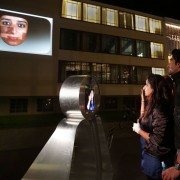
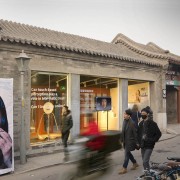

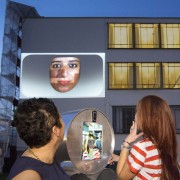
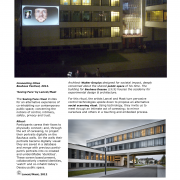
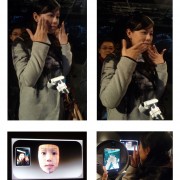
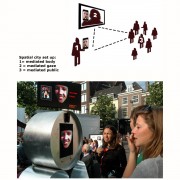


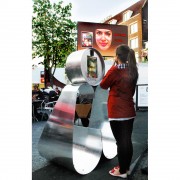
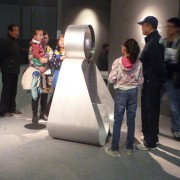
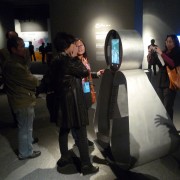
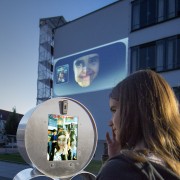
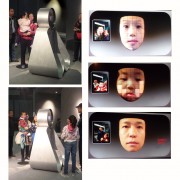

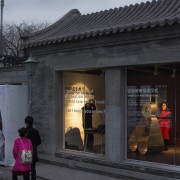
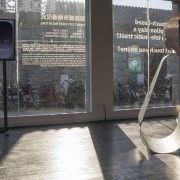
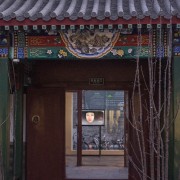
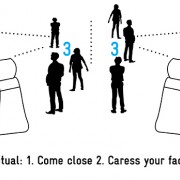
A small, intimate ritual to reflect on big socio-technological changes,
for empathy in public spaces.
"Tele-presence technologies extend our bodies beyond biological boundaries in time and space, but prevent us from touching". Arjen Mulder
Can I touch you online?
In the smart digital public domain, we are increasingly faced with the paradox of ‘the higher surveillance, the lower trust'. Saving Face is a response on increasingly trusting each other based on bio-metric control and surveillance technologies, connected to AI algorithms and social media. The artists deconstruct bio-metric control technologies to create and share a poetic 'meeting-through-touching' ritual and dialogue. Participants are invited to caress their own faces, to connect with others worldwide; to endlessly meet, caress, mirror and merge.
Smart City Meeting Ritual: 1. Come close 2. Caress your face 3. Merge and Mirror
In the public space, an interactive city sculpture interface includes a camera, algorithm, face-recognition technologies and generative database, connected to a large urban screen. People are invited in front of the camera to caress their faces. Through caressing, they ‘paint’ their portraits on the screen. The portraits appear as virtual persona's, slowly merging with the portraits of previous visitors and further merging through every face-caressing act of following participants, co-creating untraceable, fluid, networked identities. Each virtual persona is saved in a database, to be printed for a Saving Face Passport. When the installation is not used, portraits transform autoplay from the growing database, visible on the urban screen.
Artistic Strategy - Touching my face as a social interface
Traces of participants’ vulnerable, intimate gestures are real-time exposed on the urban screen, as unpredictable and unfamiliar portraits. In the public space, relations between participants’ vulnerable acts of caressing their faces and spectators are designed as an artistic strategy to enhance dialogue on social bonding and intimate connections. These hybrid encounters, in which physical experience and digital data converge, are hosted by the artists.
In dynamic, smart public spaces, the co-created virtual personas are exposed as 'a shared face' of a city square, or museum-hall’s visitors. When traveling to various geographical and cultural contexts, Saving Face playfully connects - both online and offline - different personal historical and cultural backgrounds. Participants in cities worldwide ‘Tele-Touch’ each other to meet. The portrait on screen is part of a shared, social process. Within the tradition of the composed and 'morfing' portrait, the artists orchestrate 'a social process to create a portrait'. This process connects the physical ‘realness’, that we feel when touching our faces, to the interaction with a virtual persona in the public domain. In a post-human process, for a social construct to emerge, this persona appears in the process of merging with others, as what can be called an 'alternative selfie'.
How do we experience our bodies and connections being measured and turned into fixated, controllable ‘profiles’? Bio-metric technologies interfere with our connections based on face-to-face connection and touch, from which identities may emerge as social constructs. Can touch, vital to our well-being, play again a role in connecting? Saving Face is designed to disrupt perception of ‘who sees and who is being seen, who touches and who is being touched’ among public participants. Participants are asked to ‘caress themselves and feel being touched’ to connect with others in a mixed reality, multi-sensory interface, for dialogue on new connections of empathy and trust.
Art, Science & Technology Saving Face emerged from our artistic research that we further conducted at Delft University of Technology in the context of Lancel’s PhD trajectory (Promotores: Prof. dr. Frances Brazier, Dr. Caroline Nevejan). To inspire and rethink sustainable socio-technical ecological systems, the artists deconstruct and connect automated control technologies (such as surveillance, social media, self-quantifying biometric technologies and brain computer interfaces) to human acts of intimacy, tacit knowledge, sensory and aesthetic perception - to explore a digital-synesthetic 'trust-system'.
[ I am part of the networks and the networks are part of me
... I link, therefore I am.' William J. Mitchell ]
SHOWS
2015, 56th Venice Art Biennale: China Pavillion
Curators: Beijing Contemporary Art Foundation BCAF;
Connecting Cities Network Berlin
2015 - 2016 Museum BCAC Beijing
Curators: Beijing Contemporary Art Foundation BCAF;
Connecting Cities Network Berlin*
2012 TASIE 3rd Art and Science Exhibition and Symposium Beijing
Science & Technology Museum Beijing.
Curator: Zhang Ga, Tsinghua University, China.
2013 Connecting Cities / Public art lab Berlin; Bauhaus Dessau - Ars Electronica
Curator: Susa Pop
2012 Festival aan de Werf Utrecht, NL
Curator: Rainer Hofmann
2013 TASML artists in residency / TsingHua University Beijing.
Curator: Zhang Ga
2015 Holland Festival / De Balie Amsterdam, 'Stadsleven.'
Curator: Tracy Metz
2013 Zwolle Gemeente Museum.
Curator: Adriaan de Regt
2015 'Play Perform Participate' University Utrecht.
Curators: Chiel Kattenbelt, Nanna Verhoeff (Urban Interfaces Group)
2011 ISEA Istanbul & Istanbul Art Biennale
Curator: Lanfranco Aceti
2011 Urban Screens Seminar 'Screening the City'
Curator: Geert Lovink, Intsitute for Network Cultures
2011 Iaspis Stockholm
Curator: Laura Mott
2012 TEDX Silkroad Istanbul
Curator: Ferhan Cook.
2014 Beamlab, De Zwijger Amsterdam
2015 Symposium Tangible User Interaction and Computer Science, University Twente
Curators: Gijs Huisman and Prof Jan van Erp / University Twente
2012 Conference & Masterclass 'Wireless Stories'
Curators: Sandberg Institute & Media Fonds
2012 European EIC ICT labs: 'Mediated presence group'
Prof.dr F. Brazier, Prof.dr. N. Nevejan, Dr. C. Gullström
Universities for Technology Delft, Eindhoven, Stockholm (KTH)
PRESS & PUBLICATIONS:
1) Connecting Cities Network Exhibition Catalogue. 'What Urban Media can do'. Publisher: Avedition. 2016.
Edited by Susa Pop, Tanya Toft, Nerea Calvillo, Mark Wright. The catalogue about EU funded project 'Connecting Cities Network' includes 50 media art projects in city spaces worldwide and theoretical articles of among others Claire Bishop, Maurice Benayoun, Eric Kluitenberg, Mark Shepard, Peter Weibel.
2) New Media Research Essay: 'Urban Social Spaces,Tactical Media in the Hybrid City', page 16, author: Katia Truijen, Mediamatic Amsterdam
3) ARTSPY 2015 Beijing
4) World Radio China Interview: 'Save Your Faces with Mine',
at BCAC Beijing Culture and Art Center by Zheng Yunfeng, Vincent. 2016.
In depth interview about Saving Face audience experience, artist's intension, hosting, (technical) concepts and future plans.
5) NECSUS, European Journal of Media Studies Spring 2014_'Traces',
by Nanna Verhoeff & Heidi Rae Cooley 'The navigational gesture:
Traces and tracings at the mobile touchscreen interface'
6) Arte Creative TV, Saving Face at Connecting Cities 2013
7) Holland Festival /'Stadsleven' 2015 by Tracy Metz, Lecture Lancel/Maat
8) Holland Festival / Stadsleven 2015 by Tracy Metz: Online Catalogue
9) China ZHUANGSHI journal for Art and Design / Tsinghua University Beijing. 2012. TASIE Art, Science and Technology exhibition-conference 2012
10) Art blog 'Creators Project': 'Ik scande mijn gezicht door het te strelen' by Eva Oosterveld
11) DOTS Magazine for iPads #3, by Shevia Limmen
‘Touching the Face as social Interface’.
12) Art Catalogue TASIE 2013 3rd Art & Science International Exhibition, Symposium Beijing, China.
13) Publication Art Research Group ‘Image in context’
Minerva Art Academy / Hanze University for Applied Sciences Groningen.
Authors Lancel/Maat: ‘The artists as a host’
14) Newspaper article: NRC Handelsblad 2011. By Tracy Metz.
‘Een gezicht samengesteld uit honderden gezichten‘
15) cnarts.net, by ARTRON.net 'Living Art Network "action - face"'
16) Nanna Verhoeff, Clancy Wilmott, 'Curating the city: Urban interfaces and Locative media as experimental platforms for cultural data', 116-129 in Rob Ktiching and Sung-Yueh Perng (eds.) Code and the City. London: Routledge, 2016